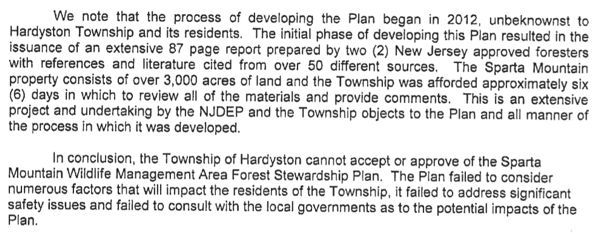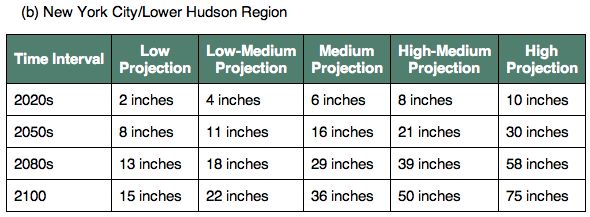PR Campaign to Rollback Septic Density Standards Kicks Off With Local Officials
Any weakening of Highlands water protections by DEP sure to face Legislative Veto
Sparta Mountain Battle An Opening Skirmish in War on Highlands
It is vital that any effort to weaken Highlands Protections be immediately and aggressively opposed BEFORE it is formally proposed in the NJ Register. Once a rule is proposed, DEP is politically committed and it will be very difficult – absent legislative veto – to stop.
[Update below]
According to an email we obtained written by the head of Christie DEP’s Office of Local Government Assistance Cindy Randazzo, on April 21, 2016, the DEP will rollout a campaign to weaken core protections of the Highlands Act, known as the septic density standards.
Those standards are a core feature of the Highlands Act that set the nation’s strictest land use density standards: one septic system per 88 acres of land in forested areas and one per 25 acres on agricultural lands.
I explain the legislative and regulatory history and technical basis, including links to key DEP documents in these prescient but premature posts:
Development restrictions imposed by the septic density standards are the primary regulatory standards that “preserve” lands in the Preservation Area of the Highlands.
They have long been opposed by land owners and developers. For over a decade, they have survived legal challenges in the Courts and political challenges in the legislature. They underpin not only DEP’s Highlands Preservation Area rules, but the Highlands Regional Master Plan (RMP).
In a March 29, 2016 email, DEP’s Randazzo wrote:
———- Forwarded message ———-
> From: Randazzo, Cindy <Cindy.Randazzo@dep.nj.gov>
> Date: Tue, Mar 29, 2016 at 3:50 PM
> Subject: IMPORTANT – DEP Highlands Municipal and County Meeting
> To: “Randazzo, Cindy” <Cindy.Randazzo@dep.nj.gov>
> Cc: “Rogers, Joseph” <Joseph.Rogers@dep.nj.gov>, “Fenderson-Singh, Nateshea” <Nateshea.Fenderson-Singh@dep.nj.gov>
Good Afternoon Municipal and County Official,
Please join us for a Highlands meeting to discuss DEP’s proposed changes to the Highlands Septic Density Rule and what it may mean to your Municipality or County.
Parsippany-Troy Township Municipal Building
1001 Parsippany Boulevard, Parsippany 07054
Thursday, April 21st from 9:00 to 10:00 am
Good afternoon indeed! And the day before Earth Day no less. I’m sure that meeting will garner public attention!
Thus starts a huge battle for the future of the Highlands, for I can assure you that if these standards are weakened, they will never be strengthened by a future DEP and thus begins the unraveling of Highlands Preservation Area protections.
It is significant that the septic density campaign rollout begins with Ms. Randazzo’s briefing of municipal and county officials.
The DEP recently was severely criticized for failure to involve local officials in major controversial initiatives, like the recent “Motorized Access Plan” (MAP) in the Pinelands, the Sparta Mountain logging plan in the Highlands, and commercial development in Liberty State Park.
DEP seems to have learned the political lesson so is now, similar to a corporate marketing campaign, conducting local outreach to garner political support.
This is completely inappropriate political behavior for a regulatory agency in the process of promulgating rules.
It is vital that any effort to weaken Highlands Protections be immediately and aggressively opposed BEFORE it is formally proposed in the NJ Register. By that time, once a rule is proposed, DEP is politically committed and it will be very difficult – absent legislative veto – to stop.
So I fired off this warning letter to DEP Commissioner Martin today to put him on notice that any rollbacks will be strongly resisted and very likely incur an immediate VETO by the Legislature as “inconsistent with the intent” of the Highlands Act: (I omitted the text on the first 2 process points):
Dear Commissioner Martin:
According to a March 29, 2016 email from Cindy Randazzo of your staff addressed to an unidentified universe of “municipal and county officials“, the Department is proposing changes to “the Highlands Septic Density Rule” (sic).
I assume Ms. Randazzo was referring to the septic density standards codified at N.J.A.C. 7:38-3.4(b) in the Department’s Highlands Water Protection and Planning Act Rules, NJAC 7:38 – 1 et seq.
Ms. Randazzo invited all those “municipal and county officials” to an April 21, 2016 meeting at the Parsippany-Troy Township Municipal Building to “discuss DEP’s proposed changes to the Highlands Septic Density Rule and what it may mean to your Municipality or County.”
For the following reasons I strongly urge you to cancel this proposed meeting and terminate any effort by the Department to – in any way – weaken the septic density standards in the Highlands rules.
I) The closed and selective meeting format is inappropriate; invites violations of the Open Public Meetings Act; and is Inconsistent with the spirit and intent of the OPMA
[…]
II) The meeting format may violate the rule-making procedures of the Administrative Procedures Act and is inconsistent with the spirit and intent of the APA
[…]
III) ANY weakening in the scope, applicability, scientific and technical methodologies that form the basis of the current standards, or the procedural requirements of the current septic density standards would be inconsistent with the legislative intent of the Highlands Act to prevent degradation of water quality.
The septic density standards in the DEP regulations are a cornerstone and vital protection to implement the Highlands Act.
The septic density standards are authorized by the following provision of the Highlands Act ( C.13:20-32 Rules, regulations, standards.; P.L. 2004, c.120):
http://www.njleg.state.nj.us/2004/Bills/PL04/120_.PDF
e. a septic system density standard established at a level to prevent the degradation of water quality, or to require the restoration of water quality, and to protect ecological uses from individual, secondary, and cumulative impacts, in consideration of deep aquifer recharge available for dilution; (emphasis supplied)
The Highlands regulations and the septic density standards have survived judicial challenges and been deemed by the Courts to be legislatively authorized, scientifically valid, an appropriate exercise of DEP discretion in accordance with the legislative standards in the Act, and not an unconstitutional taking of private property without due compensation.
The Department’s science and methodologies and regulations for implementing this provision of the Act are working well, have been implemented for over a decade now, and are well understood by the public, the Highlands Council, and the regulated community.
The legislative intent of the Highlands Act is very, very clear with respect to preventing the degradation of water quality (surface and ground waters) based on septic density
“and to protect ecological uses from individual, secondary, and cumulative impacts, in consideration of deep aquifer recharge available for dilution”.
I remind you of the Legislature’s overall intent, as expressed in the Act:
… The Legislature finds and declares that … the existing land use and environmental regulation system cannot protect the water and natural resources of the New Jersey Highlands against the environmental impacts of sprawl development.
The Legislature further finds and declares that the protection of the New Jersey Highlands, because of its vital link to the future of the State’s drinking water supplies and other key natural resources, is an issue of State level importance that cannot be left to the uncoordinated land use decisions of 88 municipalities, seven counties, and a myriad of private landowners; that the State should take action to delineate within the New Jersey Highlands a preservation area of exceptional natural resource value that includes watershed protection and other environmentally sensitive lands where stringent protection policies should be implemented; that a regional approach to land use planning in the preservation area should be established to replace the existing uncoordinated system; that such a new regional approach to land use planning should be complemented by increased standards more protective of the environment established by the Department of Environmental Protection for development in the preservation area of the New Jersey Highlands; that the new regional planning approach and the more stringent environmental regulatory standards should be accompanied, as a matter of wise public policy and fairness to property owners, by a strong and significant commitment by the State to fund the acquisition of exceptional natural resource value lands; and that in the light of the various pressures now arrayed against the New Jersey Highlands, these new approaches should be implemented as soon as possible. (emphases supplied)
Since passage of the Highlands Act, several bills have been introduced to weaken, rollback or repeal the Legislative protections and standards of the Highlands Act. Those bills have failed to gain necessary legislative majorities. This legislative history of failure by the Act’s opponents to achieve legislative rollbacks of the Act or the DEP regulations is additional evidence of the strong legislative intent to protect critical Highlands water resources.
The Department may not rollback or weaken Highlands Act protections via regulatory policymaking given these facts.
Such an effort would not only be inconsistent with Legislative intent, it would usurp Legislative policymaking powers and constitute an egregious violation of constitutional separation of powers doctrine.
For the above, and many other reasons too complex to discuss in this note, I again urge you to cancel this meeting and cease and desist in any effort to weaken Highlands protections, including the septic density standards.
I am copying the Chairs of the Legislative Committees of jurisdiction and prime sponsors of the Highlands Act.
Respectfully, Bill Wolfe
c: Senator Bob Smith, Senate Environment Committee
Senator Robert Gordon, Senate Legislative Oversight Committee
Assemblywoman Grace Spencer, Assembly Environment Committee
Assemblyman Reed Gusciora, Assembly Regulatory Oversight
[End note: Full disclosure: I wrote the legislative provision “deep aquifer recharge” and thus have a huge dog in this fight.]
[Update: Remember that DEP proposed to gut the nitrate dilution & zoning requirements in proposed WQMP rules now pending adoption.
DEP could now claim merely to be aligning the Highland septic density rules with the new WQMP nitrate dilution requirements – a two step rollback Kabuki!!!
More evidence is that DEP is kicking off a new “Stakeholder” process on revisions t the Groundwater Quality Standards tomorrow (4/11/16)- but the agenda makes no mention of nitrate dilution or septic density standards revisions.
Yet, at the same time, DEP is briefing local and county officials about septic density standards revisions.
Why the double dealing?
Don’t get played.
With the recent USGS study on background nitrate levels, the planets are aligning – a bad moon is on the rise. (and what ever became of the DEP settlement on the farm Bureau’s lawsuit?)
Boycott the Stakeholder process NOW – draw a line in the sand and mount a Highlands water quality defense campaign.






